Holmes Institute HK2042 Retail Management Analysis: Australia Report
VerifiedAdded on 2022/09/14
|13
|2910
|15
Report
AI Summary
This report provides an in-depth analysis of the Australian retail market, examining the significant changes and developments in the sector, with a particular focus on department and discount stores. It investigates the impact of online and e-commerce stores, and the evolving behavior of Australian consumers. The report identifies key drivers of change, including the influence of technology, globalization, and shifts in consumer preferences. Furthermore, it explores the future landscape of retailing in Australia, considering alternative retail store options and the impact of trends such as direct-to-consumer models, omnichannel strategies, and the use of big data and AI. The analysis also covers the strategies of major players like Woolworths and Coles. The report concludes with recommendations for the future operations of retail organizations in Australia, considering the need for adaptation and innovation in a rapidly evolving market.
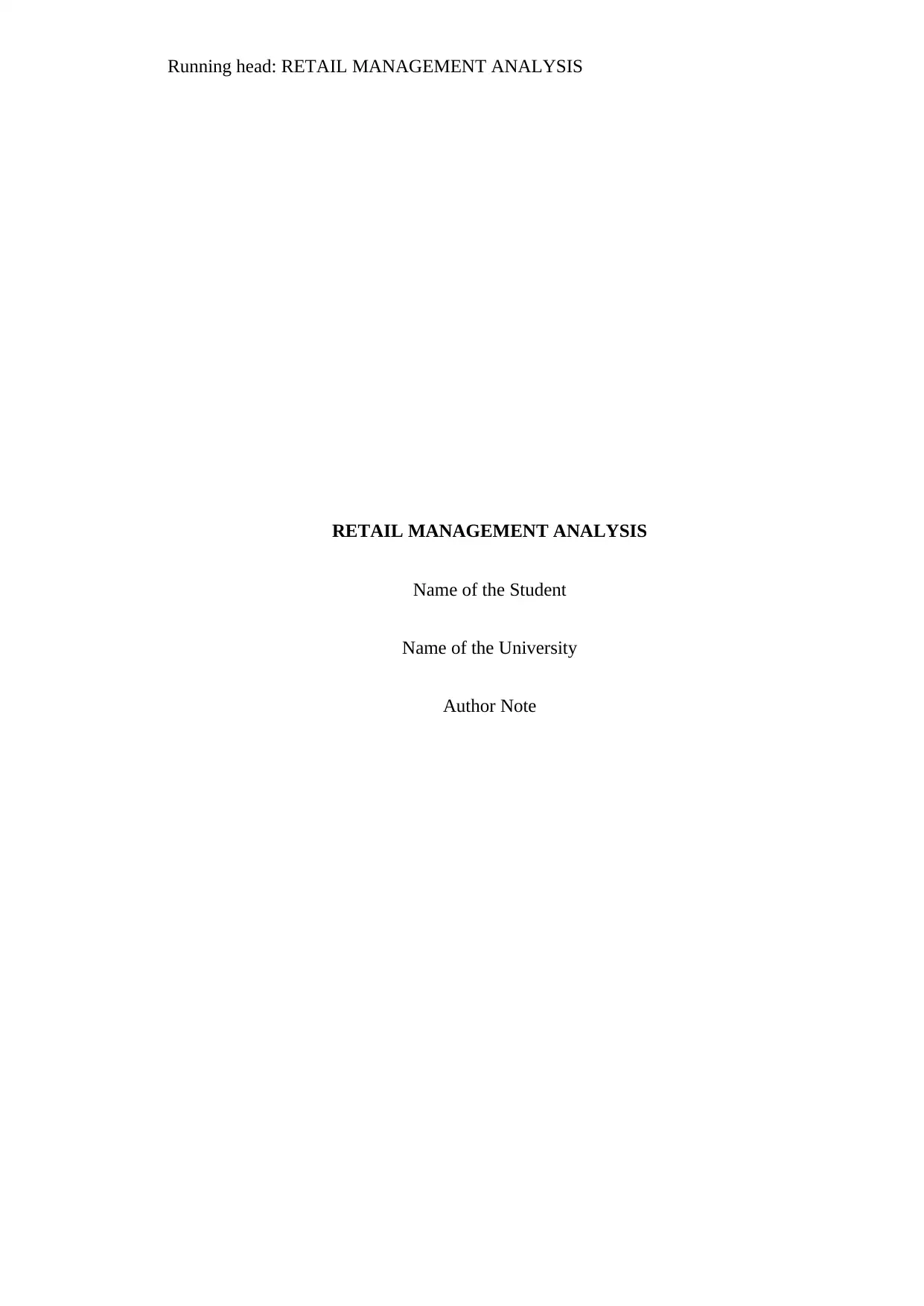
Running head: RETAIL MANAGEMENT ANALYSIS
RETAIL MANAGEMENT ANALYSIS
Name of the Student
Name of the University
Author Note
RETAIL MANAGEMENT ANALYSIS
Name of the Student
Name of the University
Author Note
Paraphrase This Document
Need a fresh take? Get an instant paraphrase of this document with our AI Paraphraser
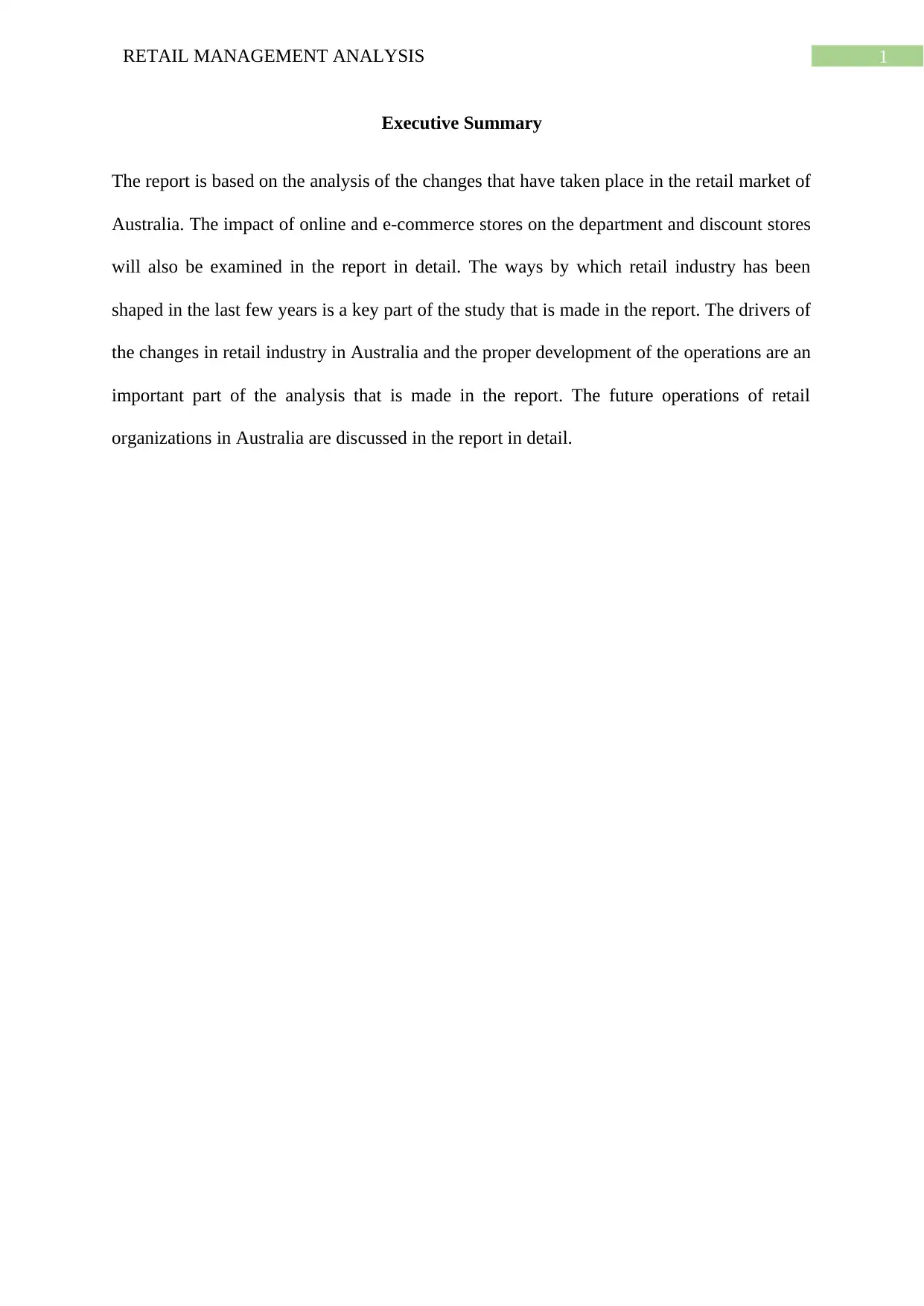
1RETAIL MANAGEMENT ANALYSIS
Executive Summary
The report is based on the analysis of the changes that have taken place in the retail market of
Australia. The impact of online and e-commerce stores on the department and discount stores
will also be examined in the report in detail. The ways by which retail industry has been
shaped in the last few years is a key part of the study that is made in the report. The drivers of
the changes in retail industry in Australia and the proper development of the operations are an
important part of the analysis that is made in the report. The future operations of retail
organizations in Australia are discussed in the report in detail.
Executive Summary
The report is based on the analysis of the changes that have taken place in the retail market of
Australia. The impact of online and e-commerce stores on the department and discount stores
will also be examined in the report in detail. The ways by which retail industry has been
shaped in the last few years is a key part of the study that is made in the report. The drivers of
the changes in retail industry in Australia and the proper development of the operations are an
important part of the analysis that is made in the report. The future operations of retail
organizations in Australia are discussed in the report in detail.
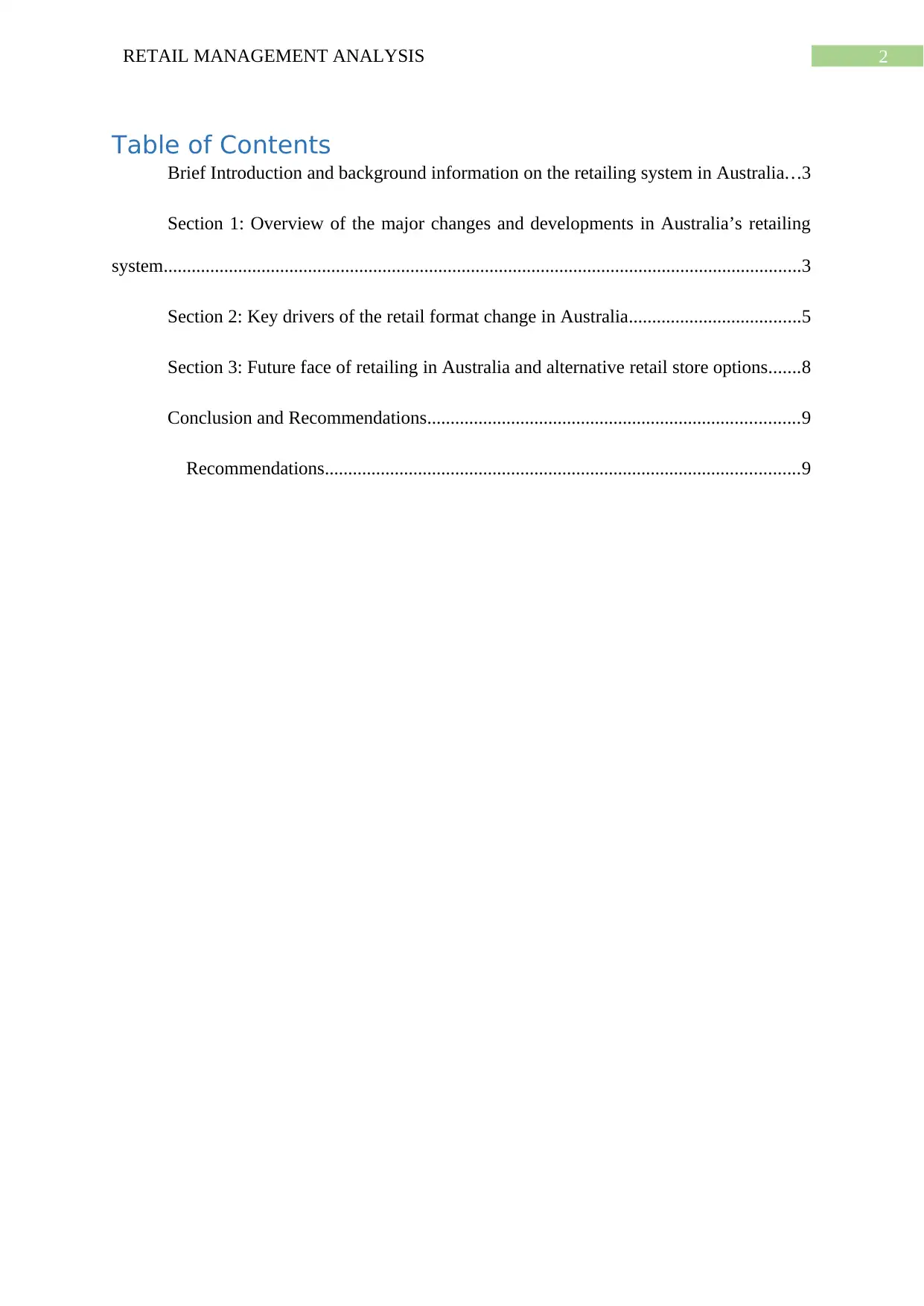
2RETAIL MANAGEMENT ANALYSIS
Table of Contents
Brief Introduction and background information on the retailing system in Australia...3
Section 1: Overview of the major changes and developments in Australia’s retailing
system.........................................................................................................................................3
Section 2: Key drivers of the retail format change in Australia.....................................5
Section 3: Future face of retailing in Australia and alternative retail store options.......8
Conclusion and Recommendations................................................................................9
Recommendations......................................................................................................9
Table of Contents
Brief Introduction and background information on the retailing system in Australia...3
Section 1: Overview of the major changes and developments in Australia’s retailing
system.........................................................................................................................................3
Section 2: Key drivers of the retail format change in Australia.....................................5
Section 3: Future face of retailing in Australia and alternative retail store options.......8
Conclusion and Recommendations................................................................................9
Recommendations......................................................................................................9
⊘ This is a preview!⊘
Do you want full access?
Subscribe today to unlock all pages.

Trusted by 1+ million students worldwide
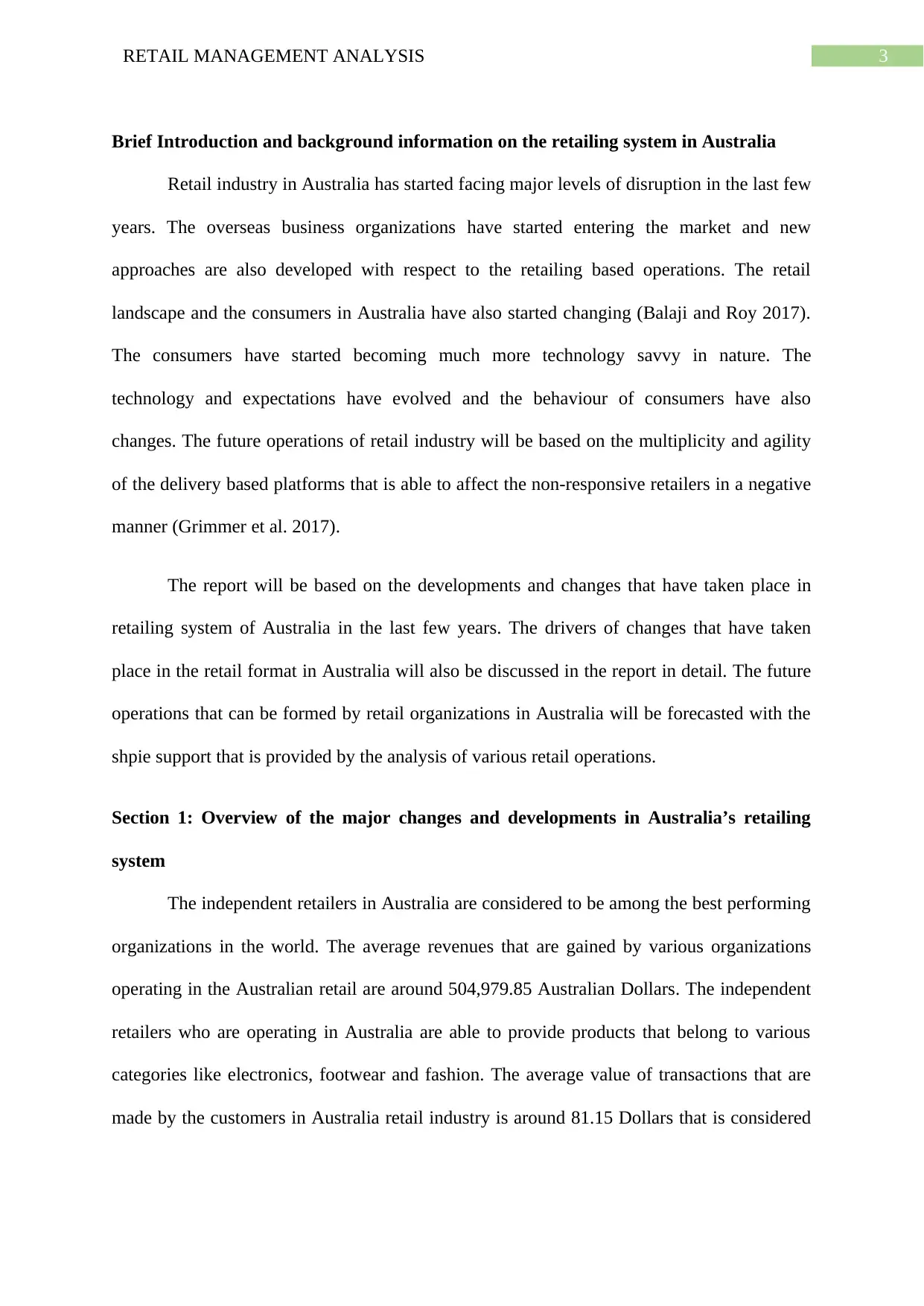
3RETAIL MANAGEMENT ANALYSIS
Brief Introduction and background information on the retailing system in Australia
Retail industry in Australia has started facing major levels of disruption in the last few
years. The overseas business organizations have started entering the market and new
approaches are also developed with respect to the retailing based operations. The retail
landscape and the consumers in Australia have also started changing (Balaji and Roy 2017).
The consumers have started becoming much more technology savvy in nature. The
technology and expectations have evolved and the behaviour of consumers have also
changes. The future operations of retail industry will be based on the multiplicity and agility
of the delivery based platforms that is able to affect the non-responsive retailers in a negative
manner (Grimmer et al. 2017).
The report will be based on the developments and changes that have taken place in
retailing system of Australia in the last few years. The drivers of changes that have taken
place in the retail format in Australia will also be discussed in the report in detail. The future
operations that can be formed by retail organizations in Australia will be forecasted with the
shpie support that is provided by the analysis of various retail operations.
Section 1: Overview of the major changes and developments in Australia’s retailing
system
The independent retailers in Australia are considered to be among the best performing
organizations in the world. The average revenues that are gained by various organizations
operating in the Australian retail are around 504,979.85 Australian Dollars. The independent
retailers who are operating in Australia are able to provide products that belong to various
categories like electronics, footwear and fashion. The average value of transactions that are
made by the customers in Australia retail industry is around 81.15 Dollars that is considered
Brief Introduction and background information on the retailing system in Australia
Retail industry in Australia has started facing major levels of disruption in the last few
years. The overseas business organizations have started entering the market and new
approaches are also developed with respect to the retailing based operations. The retail
landscape and the consumers in Australia have also started changing (Balaji and Roy 2017).
The consumers have started becoming much more technology savvy in nature. The
technology and expectations have evolved and the behaviour of consumers have also
changes. The future operations of retail industry will be based on the multiplicity and agility
of the delivery based platforms that is able to affect the non-responsive retailers in a negative
manner (Grimmer et al. 2017).
The report will be based on the developments and changes that have taken place in
retailing system of Australia in the last few years. The drivers of changes that have taken
place in the retail format in Australia will also be discussed in the report in detail. The future
operations that can be formed by retail organizations in Australia will be forecasted with the
shpie support that is provided by the analysis of various retail operations.
Section 1: Overview of the major changes and developments in Australia’s retailing
system
The independent retailers in Australia are considered to be among the best performing
organizations in the world. The average revenues that are gained by various organizations
operating in the Australian retail are around 504,979.85 Australian Dollars. The independent
retailers who are operating in Australia are able to provide products that belong to various
categories like electronics, footwear and fashion. The average value of transactions that are
made by the customers in Australia retail industry is around 81.15 Dollars that is considered
Paraphrase This Document
Need a fresh take? Get an instant paraphrase of this document with our AI Paraphraser
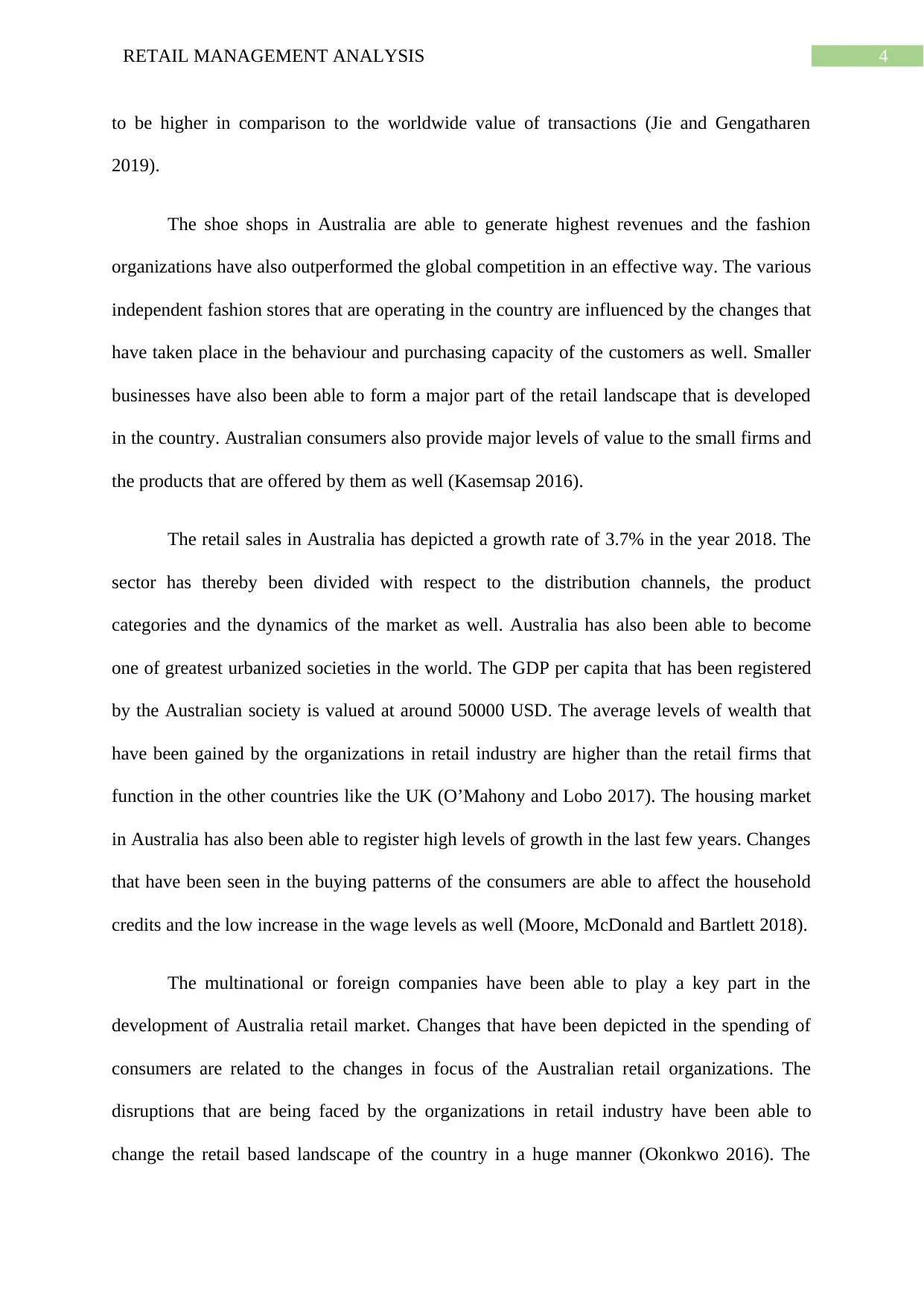
4RETAIL MANAGEMENT ANALYSIS
to be higher in comparison to the worldwide value of transactions (Jie and Gengatharen
2019).
The shoe shops in Australia are able to generate highest revenues and the fashion
organizations have also outperformed the global competition in an effective way. The various
independent fashion stores that are operating in the country are influenced by the changes that
have taken place in the behaviour and purchasing capacity of the customers as well. Smaller
businesses have also been able to form a major part of the retail landscape that is developed
in the country. Australian consumers also provide major levels of value to the small firms and
the products that are offered by them as well (Kasemsap 2016).
The retail sales in Australia has depicted a growth rate of 3.7% in the year 2018. The
sector has thereby been divided with respect to the distribution channels, the product
categories and the dynamics of the market as well. Australia has also been able to become
one of greatest urbanized societies in the world. The GDP per capita that has been registered
by the Australian society is valued at around 50000 USD. The average levels of wealth that
have been gained by the organizations in retail industry are higher than the retail firms that
function in the other countries like the UK (O’Mahony and Lobo 2017). The housing market
in Australia has also been able to register high levels of growth in the last few years. Changes
that have been seen in the buying patterns of the consumers are able to affect the household
credits and the low increase in the wage levels as well (Moore, McDonald and Bartlett 2018).
The multinational or foreign companies have been able to play a key part in the
development of Australia retail market. Changes that have been depicted in the spending of
consumers are related to the changes in focus of the Australian retail organizations. The
disruptions that are being faced by the organizations in retail industry have been able to
change the retail based landscape of the country in a huge manner (Okonkwo 2016). The
to be higher in comparison to the worldwide value of transactions (Jie and Gengatharen
2019).
The shoe shops in Australia are able to generate highest revenues and the fashion
organizations have also outperformed the global competition in an effective way. The various
independent fashion stores that are operating in the country are influenced by the changes that
have taken place in the behaviour and purchasing capacity of the customers as well. Smaller
businesses have also been able to form a major part of the retail landscape that is developed
in the country. Australian consumers also provide major levels of value to the small firms and
the products that are offered by them as well (Kasemsap 2016).
The retail sales in Australia has depicted a growth rate of 3.7% in the year 2018. The
sector has thereby been divided with respect to the distribution channels, the product
categories and the dynamics of the market as well. Australia has also been able to become
one of greatest urbanized societies in the world. The GDP per capita that has been registered
by the Australian society is valued at around 50000 USD. The average levels of wealth that
have been gained by the organizations in retail industry are higher than the retail firms that
function in the other countries like the UK (O’Mahony and Lobo 2017). The housing market
in Australia has also been able to register high levels of growth in the last few years. Changes
that have been seen in the buying patterns of the consumers are able to affect the household
credits and the low increase in the wage levels as well (Moore, McDonald and Bartlett 2018).
The multinational or foreign companies have been able to play a key part in the
development of Australia retail market. Changes that have been depicted in the spending of
consumers are related to the changes in focus of the Australian retail organizations. The
disruptions that are being faced by the organizations in retail industry have been able to
change the retail based landscape of the country in a huge manner (Okonkwo 2016). The
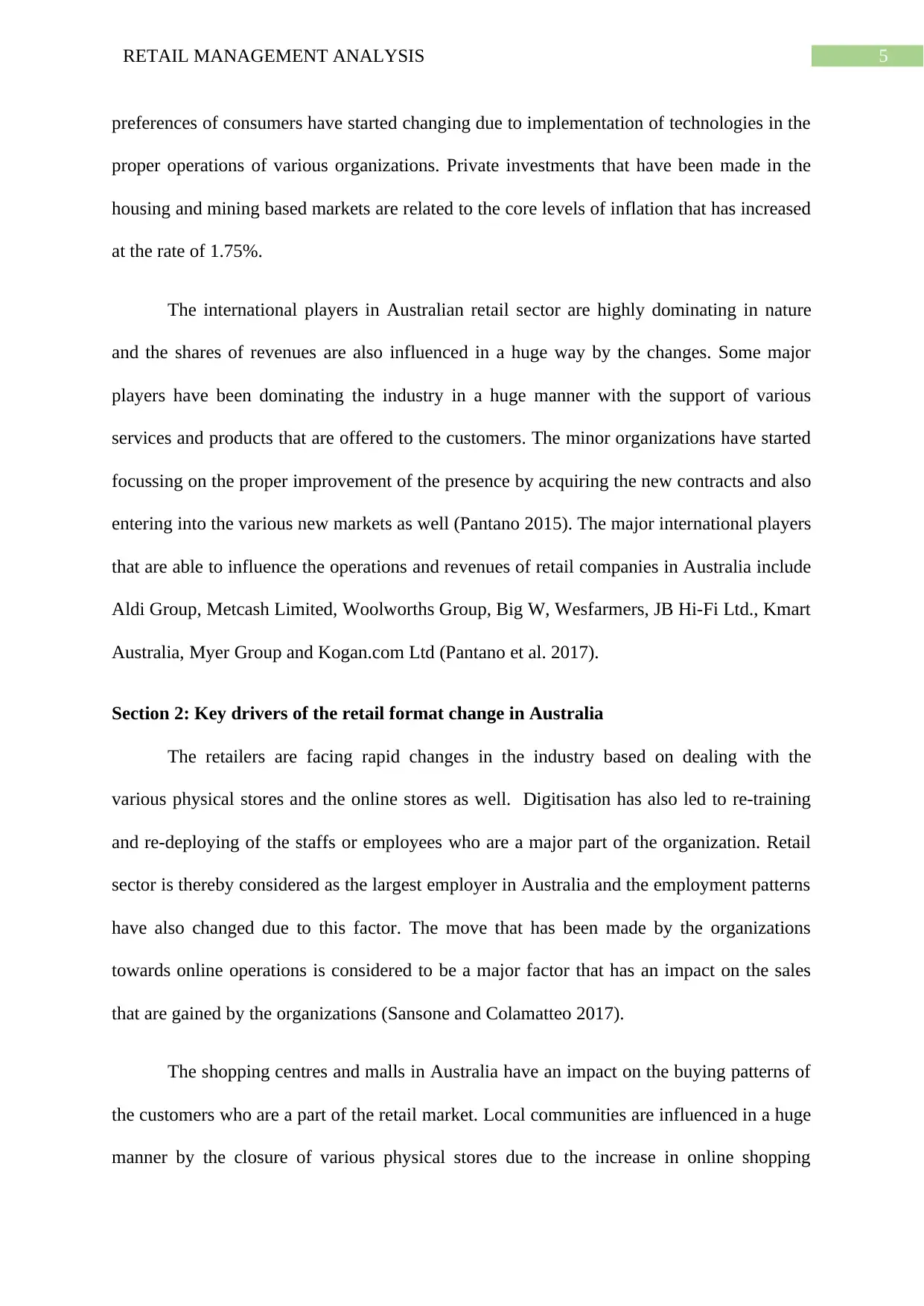
5RETAIL MANAGEMENT ANALYSIS
preferences of consumers have started changing due to implementation of technologies in the
proper operations of various organizations. Private investments that have been made in the
housing and mining based markets are related to the core levels of inflation that has increased
at the rate of 1.75%.
The international players in Australian retail sector are highly dominating in nature
and the shares of revenues are also influenced in a huge way by the changes. Some major
players have been dominating the industry in a huge manner with the support of various
services and products that are offered to the customers. The minor organizations have started
focussing on the proper improvement of the presence by acquiring the new contracts and also
entering into the various new markets as well (Pantano 2015). The major international players
that are able to influence the operations and revenues of retail companies in Australia include
Aldi Group, Metcash Limited, Woolworths Group, Big W, Wesfarmers, JB Hi-Fi Ltd., Kmart
Australia, Myer Group and Kogan.com Ltd (Pantano et al. 2017).
Section 2: Key drivers of the retail format change in Australia
The retailers are facing rapid changes in the industry based on dealing with the
various physical stores and the online stores as well. Digitisation has also led to re-training
and re-deploying of the staffs or employees who are a major part of the organization. Retail
sector is thereby considered as the largest employer in Australia and the employment patterns
have also changed due to this factor. The move that has been made by the organizations
towards online operations is considered to be a major factor that has an impact on the sales
that are gained by the organizations (Sansone and Colamatteo 2017).
The shopping centres and malls in Australia have an impact on the buying patterns of
the customers who are a part of the retail market. Local communities are influenced in a huge
manner by the closure of various physical stores due to the increase in online shopping
preferences of consumers have started changing due to implementation of technologies in the
proper operations of various organizations. Private investments that have been made in the
housing and mining based markets are related to the core levels of inflation that has increased
at the rate of 1.75%.
The international players in Australian retail sector are highly dominating in nature
and the shares of revenues are also influenced in a huge way by the changes. Some major
players have been dominating the industry in a huge manner with the support of various
services and products that are offered to the customers. The minor organizations have started
focussing on the proper improvement of the presence by acquiring the new contracts and also
entering into the various new markets as well (Pantano 2015). The major international players
that are able to influence the operations and revenues of retail companies in Australia include
Aldi Group, Metcash Limited, Woolworths Group, Big W, Wesfarmers, JB Hi-Fi Ltd., Kmart
Australia, Myer Group and Kogan.com Ltd (Pantano et al. 2017).
Section 2: Key drivers of the retail format change in Australia
The retailers are facing rapid changes in the industry based on dealing with the
various physical stores and the online stores as well. Digitisation has also led to re-training
and re-deploying of the staffs or employees who are a major part of the organization. Retail
sector is thereby considered as the largest employer in Australia and the employment patterns
have also changed due to this factor. The move that has been made by the organizations
towards online operations is considered to be a major factor that has an impact on the sales
that are gained by the organizations (Sansone and Colamatteo 2017).
The shopping centres and malls in Australia have an impact on the buying patterns of
the customers who are a part of the retail market. Local communities are influenced in a huge
manner by the closure of various physical stores due to the increase in online shopping
⊘ This is a preview!⊘
Do you want full access?
Subscribe today to unlock all pages.

Trusted by 1+ million students worldwide
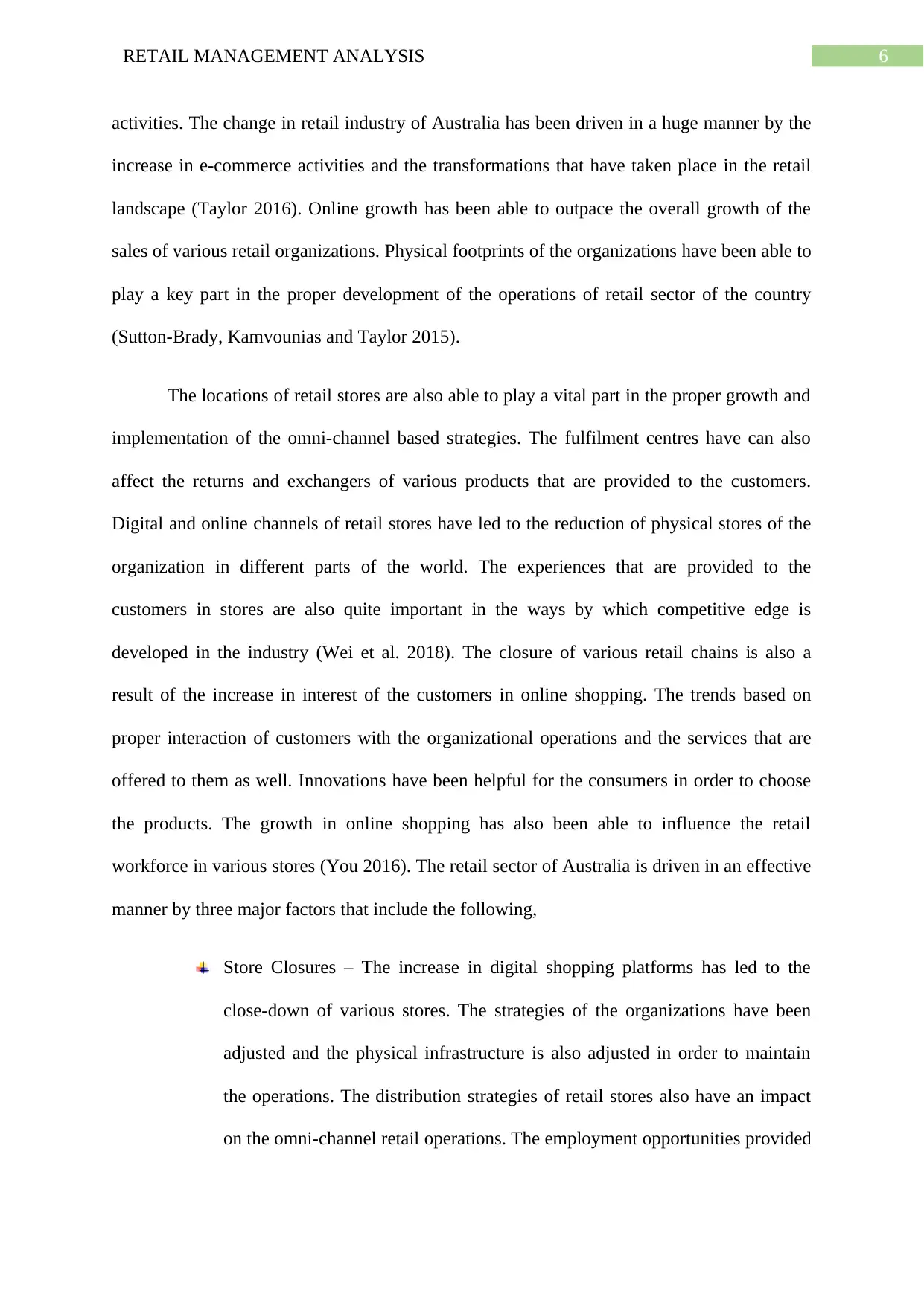
6RETAIL MANAGEMENT ANALYSIS
activities. The change in retail industry of Australia has been driven in a huge manner by the
increase in e-commerce activities and the transformations that have taken place in the retail
landscape (Taylor 2016). Online growth has been able to outpace the overall growth of the
sales of various retail organizations. Physical footprints of the organizations have been able to
play a key part in the proper development of the operations of retail sector of the country
(Sutton-Brady, Kamvounias and Taylor 2015).
The locations of retail stores are also able to play a vital part in the proper growth and
implementation of the omni-channel based strategies. The fulfilment centres have can also
affect the returns and exchangers of various products that are provided to the customers.
Digital and online channels of retail stores have led to the reduction of physical stores of the
organization in different parts of the world. The experiences that are provided to the
customers in stores are also quite important in the ways by which competitive edge is
developed in the industry (Wei et al. 2018). The closure of various retail chains is also a
result of the increase in interest of the customers in online shopping. The trends based on
proper interaction of customers with the organizational operations and the services that are
offered to them as well. Innovations have been helpful for the consumers in order to choose
the products. The growth in online shopping has also been able to influence the retail
workforce in various stores (You 2016). The retail sector of Australia is driven in an effective
manner by three major factors that include the following,
Store Closures – The increase in digital shopping platforms has led to the
close-down of various stores. The strategies of the organizations have been
adjusted and the physical infrastructure is also adjusted in order to maintain
the operations. The distribution strategies of retail stores also have an impact
on the omni-channel retail operations. The employment opportunities provided
activities. The change in retail industry of Australia has been driven in a huge manner by the
increase in e-commerce activities and the transformations that have taken place in the retail
landscape (Taylor 2016). Online growth has been able to outpace the overall growth of the
sales of various retail organizations. Physical footprints of the organizations have been able to
play a key part in the proper development of the operations of retail sector of the country
(Sutton-Brady, Kamvounias and Taylor 2015).
The locations of retail stores are also able to play a vital part in the proper growth and
implementation of the omni-channel based strategies. The fulfilment centres have can also
affect the returns and exchangers of various products that are provided to the customers.
Digital and online channels of retail stores have led to the reduction of physical stores of the
organization in different parts of the world. The experiences that are provided to the
customers in stores are also quite important in the ways by which competitive edge is
developed in the industry (Wei et al. 2018). The closure of various retail chains is also a
result of the increase in interest of the customers in online shopping. The trends based on
proper interaction of customers with the organizational operations and the services that are
offered to them as well. Innovations have been helpful for the consumers in order to choose
the products. The growth in online shopping has also been able to influence the retail
workforce in various stores (You 2016). The retail sector of Australia is driven in an effective
manner by three major factors that include the following,
Store Closures – The increase in digital shopping platforms has led to the
close-down of various stores. The strategies of the organizations have been
adjusted and the physical infrastructure is also adjusted in order to maintain
the operations. The distribution strategies of retail stores also have an impact
on the omni-channel retail operations. The employment opportunities provided
Paraphrase This Document
Need a fresh take? Get an instant paraphrase of this document with our AI Paraphraser
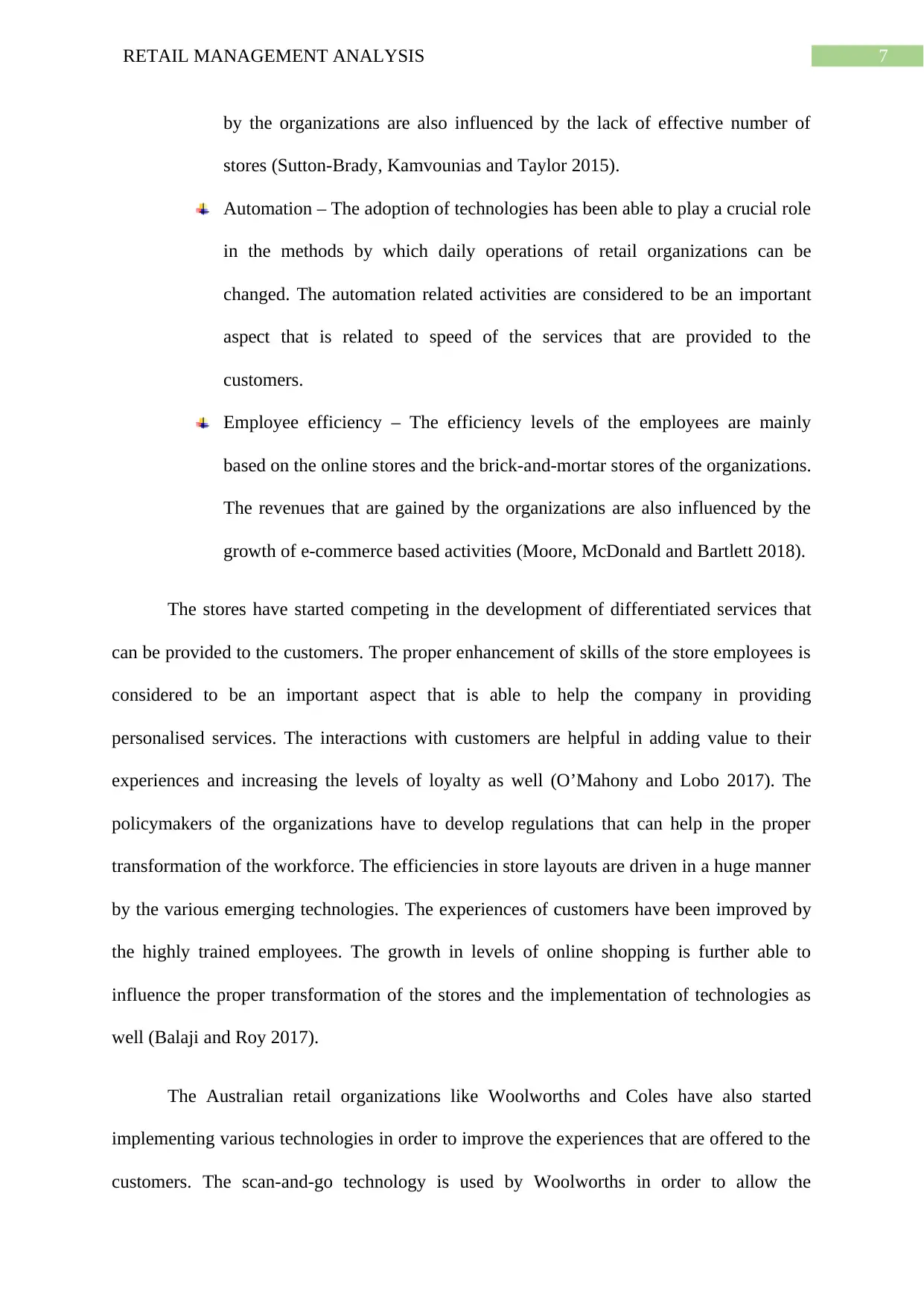
7RETAIL MANAGEMENT ANALYSIS
by the organizations are also influenced by the lack of effective number of
stores (Sutton-Brady, Kamvounias and Taylor 2015).
Automation – The adoption of technologies has been able to play a crucial role
in the methods by which daily operations of retail organizations can be
changed. The automation related activities are considered to be an important
aspect that is related to speed of the services that are provided to the
customers.
Employee efficiency – The efficiency levels of the employees are mainly
based on the online stores and the brick-and-mortar stores of the organizations.
The revenues that are gained by the organizations are also influenced by the
growth of e-commerce based activities (Moore, McDonald and Bartlett 2018).
The stores have started competing in the development of differentiated services that
can be provided to the customers. The proper enhancement of skills of the store employees is
considered to be an important aspect that is able to help the company in providing
personalised services. The interactions with customers are helpful in adding value to their
experiences and increasing the levels of loyalty as well (O’Mahony and Lobo 2017). The
policymakers of the organizations have to develop regulations that can help in the proper
transformation of the workforce. The efficiencies in store layouts are driven in a huge manner
by the various emerging technologies. The experiences of customers have been improved by
the highly trained employees. The growth in levels of online shopping is further able to
influence the proper transformation of the stores and the implementation of technologies as
well (Balaji and Roy 2017).
The Australian retail organizations like Woolworths and Coles have also started
implementing various technologies in order to improve the experiences that are offered to the
customers. The scan-and-go technology is used by Woolworths in order to allow the
by the organizations are also influenced by the lack of effective number of
stores (Sutton-Brady, Kamvounias and Taylor 2015).
Automation – The adoption of technologies has been able to play a crucial role
in the methods by which daily operations of retail organizations can be
changed. The automation related activities are considered to be an important
aspect that is related to speed of the services that are provided to the
customers.
Employee efficiency – The efficiency levels of the employees are mainly
based on the online stores and the brick-and-mortar stores of the organizations.
The revenues that are gained by the organizations are also influenced by the
growth of e-commerce based activities (Moore, McDonald and Bartlett 2018).
The stores have started competing in the development of differentiated services that
can be provided to the customers. The proper enhancement of skills of the store employees is
considered to be an important aspect that is able to help the company in providing
personalised services. The interactions with customers are helpful in adding value to their
experiences and increasing the levels of loyalty as well (O’Mahony and Lobo 2017). The
policymakers of the organizations have to develop regulations that can help in the proper
transformation of the workforce. The efficiencies in store layouts are driven in a huge manner
by the various emerging technologies. The experiences of customers have been improved by
the highly trained employees. The growth in levels of online shopping is further able to
influence the proper transformation of the stores and the implementation of technologies as
well (Balaji and Roy 2017).
The Australian retail organizations like Woolworths and Coles have also started
implementing various technologies in order to improve the experiences that are offered to the
customers. The scan-and-go technology is used by Woolworths in order to allow the
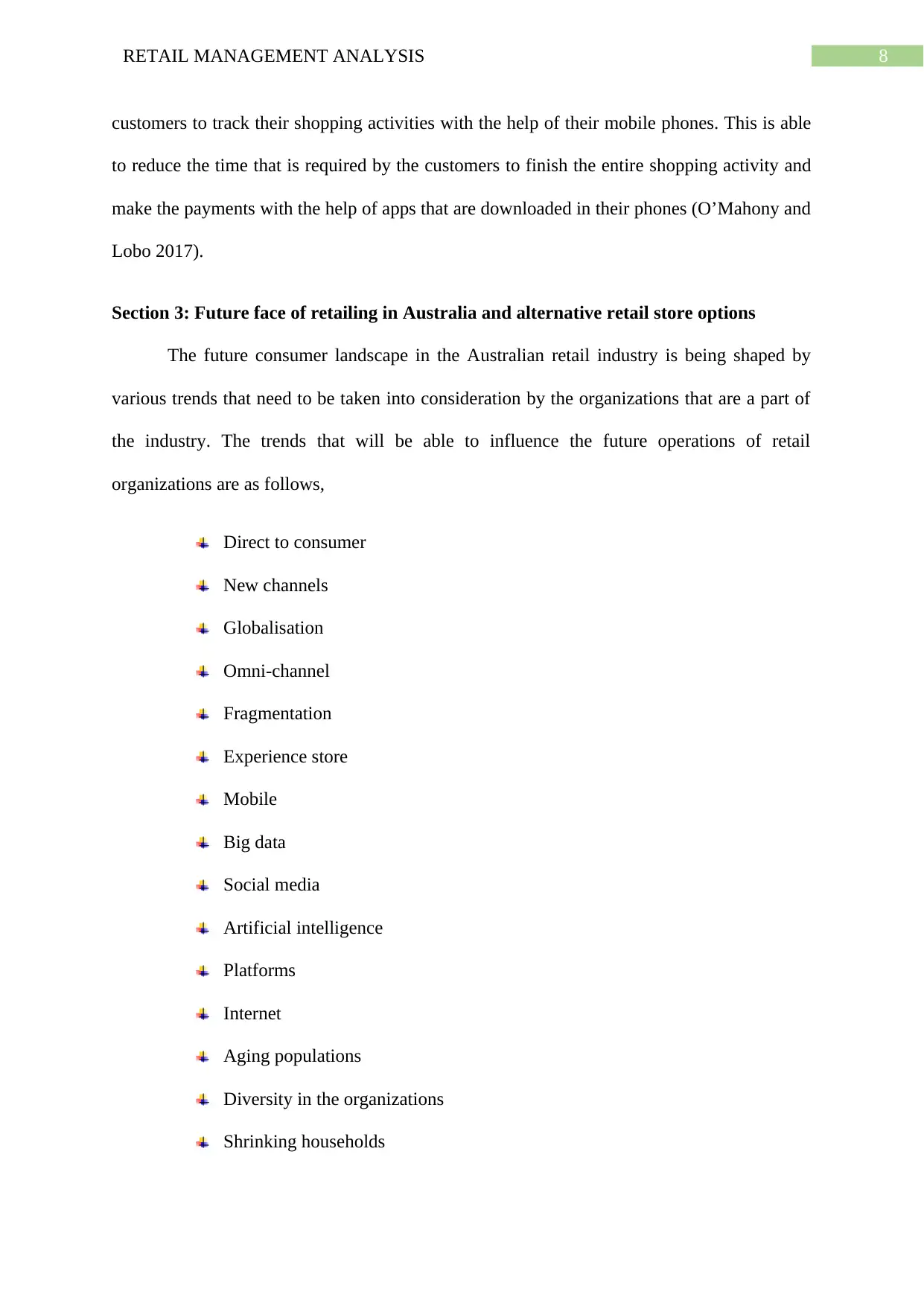
8RETAIL MANAGEMENT ANALYSIS
customers to track their shopping activities with the help of their mobile phones. This is able
to reduce the time that is required by the customers to finish the entire shopping activity and
make the payments with the help of apps that are downloaded in their phones (O’Mahony and
Lobo 2017).
Section 3: Future face of retailing in Australia and alternative retail store options
The future consumer landscape in the Australian retail industry is being shaped by
various trends that need to be taken into consideration by the organizations that are a part of
the industry. The trends that will be able to influence the future operations of retail
organizations are as follows,
Direct to consumer
New channels
Globalisation
Omni-channel
Fragmentation
Experience store
Mobile
Big data
Social media
Artificial intelligence
Platforms
Internet
Aging populations
Diversity in the organizations
Shrinking households
customers to track their shopping activities with the help of their mobile phones. This is able
to reduce the time that is required by the customers to finish the entire shopping activity and
make the payments with the help of apps that are downloaded in their phones (O’Mahony and
Lobo 2017).
Section 3: Future face of retailing in Australia and alternative retail store options
The future consumer landscape in the Australian retail industry is being shaped by
various trends that need to be taken into consideration by the organizations that are a part of
the industry. The trends that will be able to influence the future operations of retail
organizations are as follows,
Direct to consumer
New channels
Globalisation
Omni-channel
Fragmentation
Experience store
Mobile
Big data
Social media
Artificial intelligence
Platforms
Internet
Aging populations
Diversity in the organizations
Shrinking households
⊘ This is a preview!⊘
Do you want full access?
Subscribe today to unlock all pages.

Trusted by 1+ million students worldwide
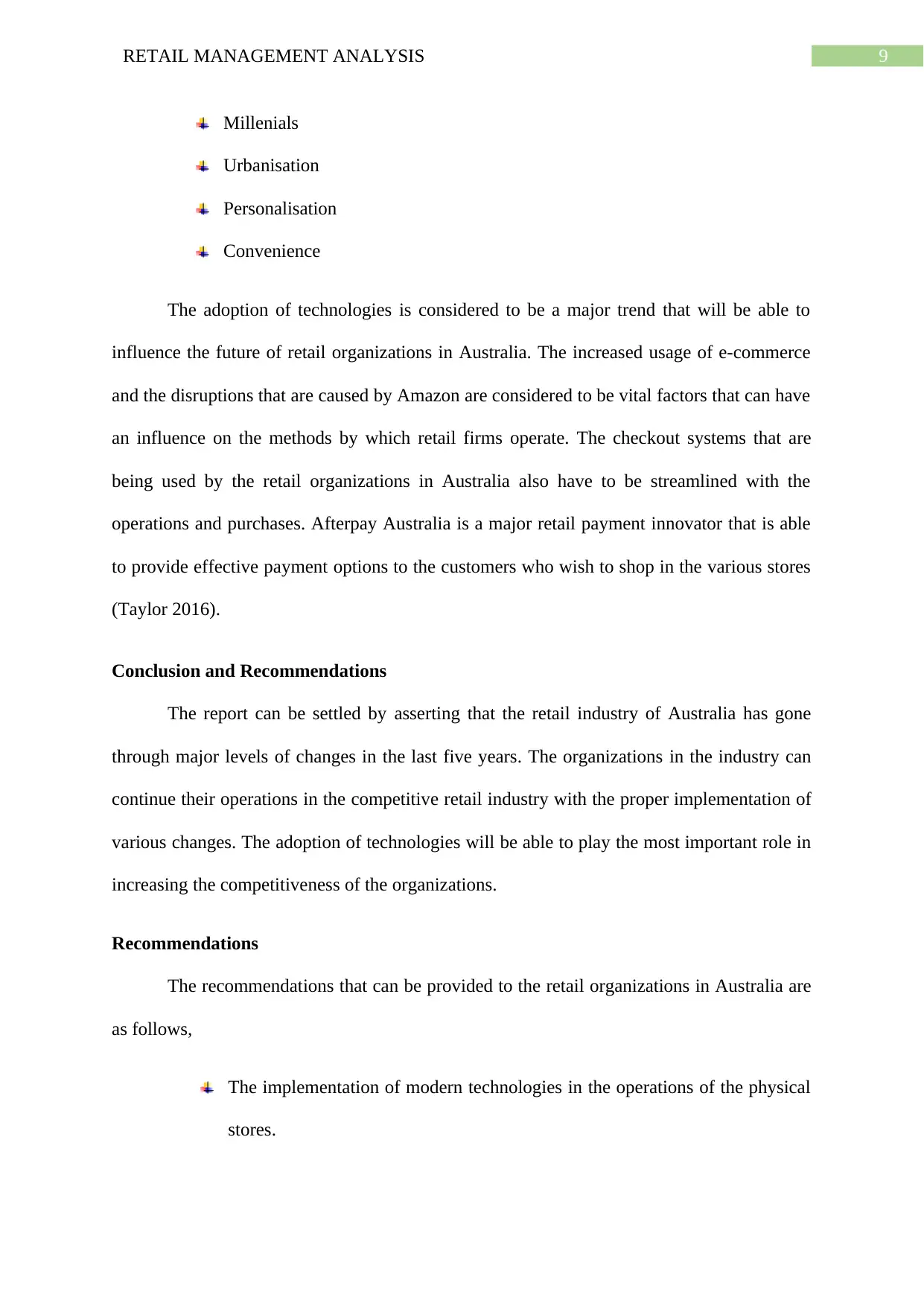
9RETAIL MANAGEMENT ANALYSIS
Millenials
Urbanisation
Personalisation
Convenience
The adoption of technologies is considered to be a major trend that will be able to
influence the future of retail organizations in Australia. The increased usage of e-commerce
and the disruptions that are caused by Amazon are considered to be vital factors that can have
an influence on the methods by which retail firms operate. The checkout systems that are
being used by the retail organizations in Australia also have to be streamlined with the
operations and purchases. Afterpay Australia is a major retail payment innovator that is able
to provide effective payment options to the customers who wish to shop in the various stores
(Taylor 2016).
Conclusion and Recommendations
The report can be settled by asserting that the retail industry of Australia has gone
through major levels of changes in the last five years. The organizations in the industry can
continue their operations in the competitive retail industry with the proper implementation of
various changes. The adoption of technologies will be able to play the most important role in
increasing the competitiveness of the organizations.
Recommendations
The recommendations that can be provided to the retail organizations in Australia are
as follows,
The implementation of modern technologies in the operations of the physical
stores.
Millenials
Urbanisation
Personalisation
Convenience
The adoption of technologies is considered to be a major trend that will be able to
influence the future of retail organizations in Australia. The increased usage of e-commerce
and the disruptions that are caused by Amazon are considered to be vital factors that can have
an influence on the methods by which retail firms operate. The checkout systems that are
being used by the retail organizations in Australia also have to be streamlined with the
operations and purchases. Afterpay Australia is a major retail payment innovator that is able
to provide effective payment options to the customers who wish to shop in the various stores
(Taylor 2016).
Conclusion and Recommendations
The report can be settled by asserting that the retail industry of Australia has gone
through major levels of changes in the last five years. The organizations in the industry can
continue their operations in the competitive retail industry with the proper implementation of
various changes. The adoption of technologies will be able to play the most important role in
increasing the competitiveness of the organizations.
Recommendations
The recommendations that can be provided to the retail organizations in Australia are
as follows,
The implementation of modern technologies in the operations of the physical
stores.
Paraphrase This Document
Need a fresh take? Get an instant paraphrase of this document with our AI Paraphraser
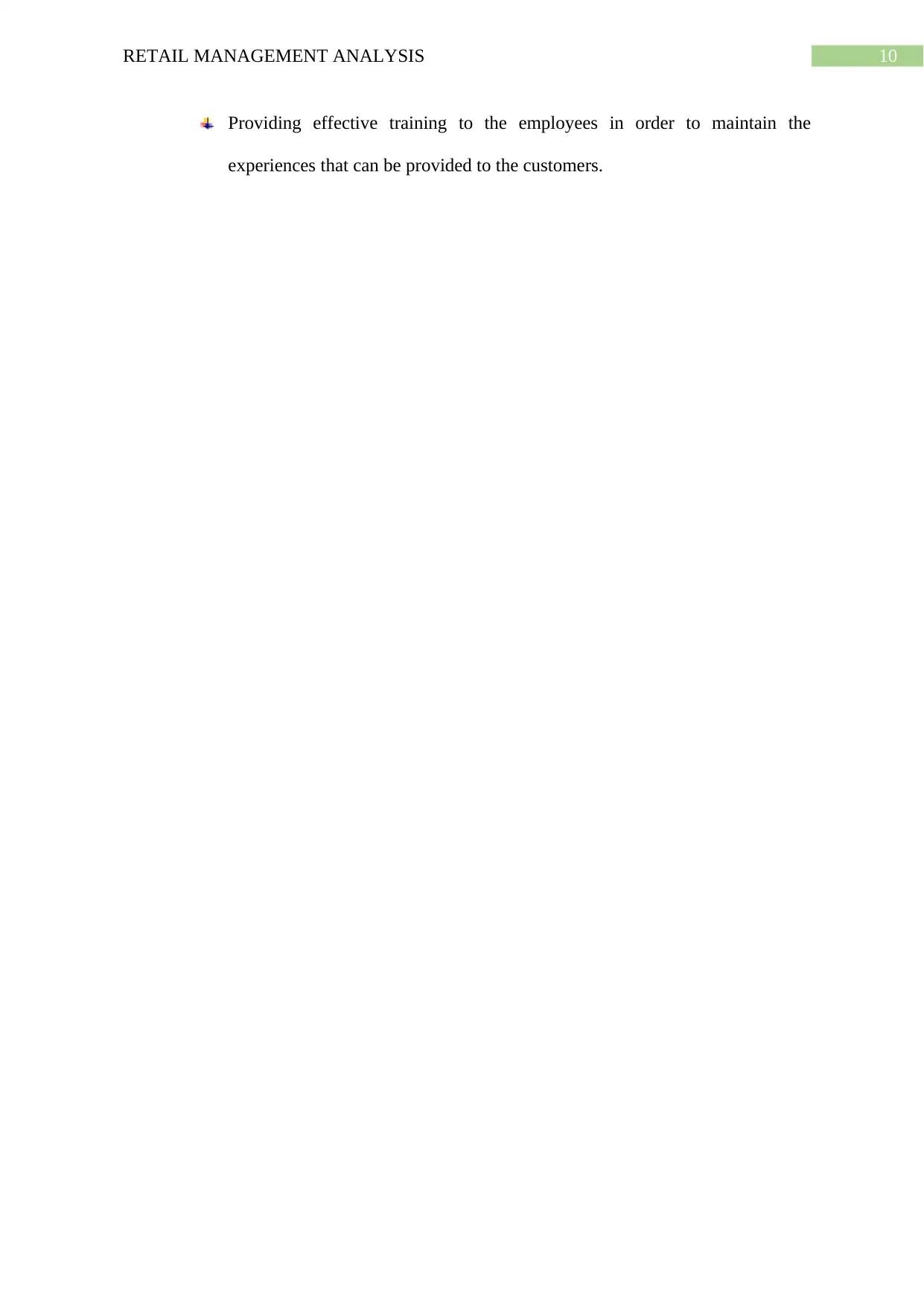
10RETAIL MANAGEMENT ANALYSIS
Providing effective training to the employees in order to maintain the
experiences that can be provided to the customers.
Providing effective training to the employees in order to maintain the
experiences that can be provided to the customers.
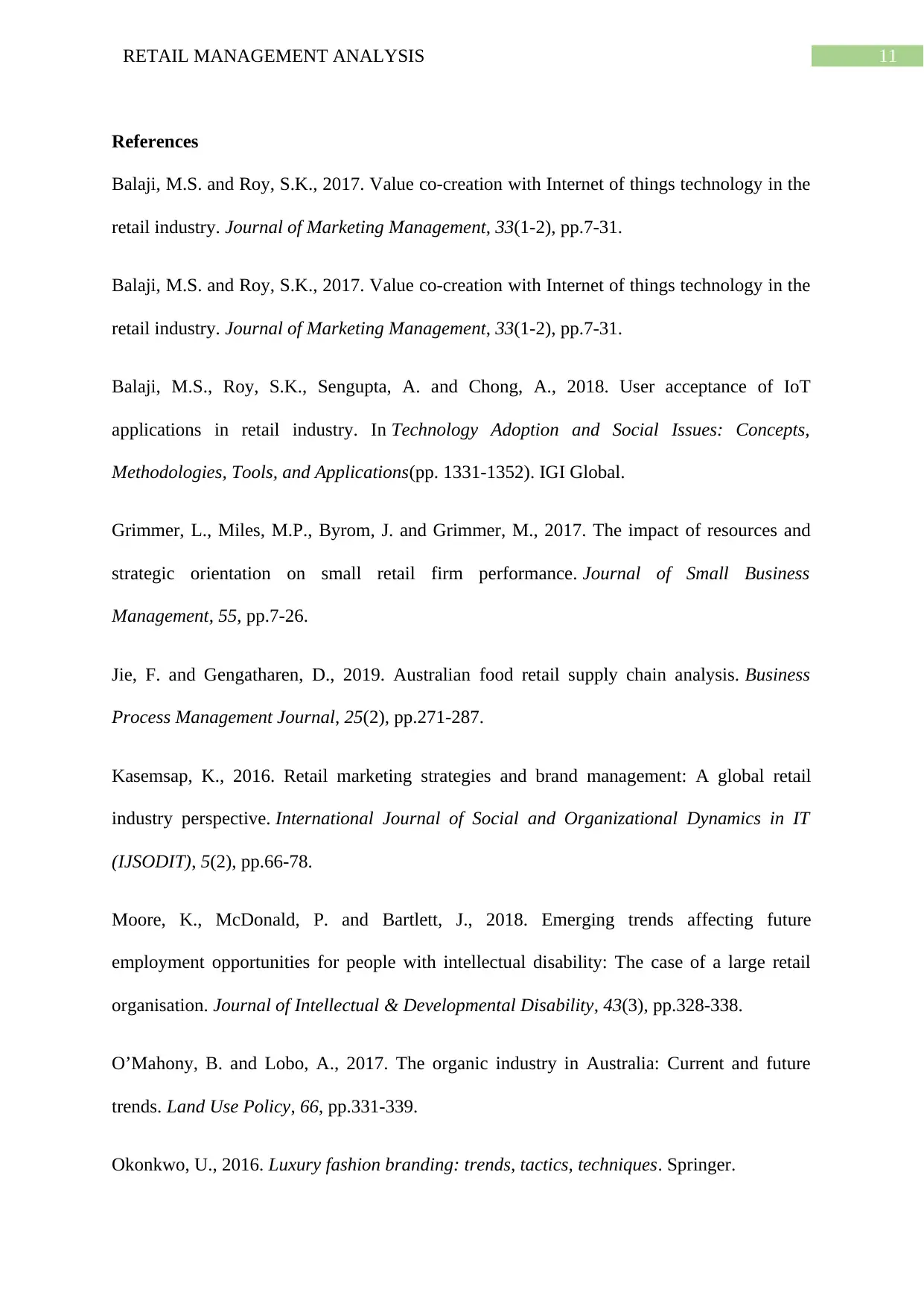
11RETAIL MANAGEMENT ANALYSIS
References
Balaji, M.S. and Roy, S.K., 2017. Value co-creation with Internet of things technology in the
retail industry. Journal of Marketing Management, 33(1-2), pp.7-31.
Balaji, M.S. and Roy, S.K., 2017. Value co-creation with Internet of things technology in the
retail industry. Journal of Marketing Management, 33(1-2), pp.7-31.
Balaji, M.S., Roy, S.K., Sengupta, A. and Chong, A., 2018. User acceptance of IoT
applications in retail industry. In Technology Adoption and Social Issues: Concepts,
Methodologies, Tools, and Applications(pp. 1331-1352). IGI Global.
Grimmer, L., Miles, M.P., Byrom, J. and Grimmer, M., 2017. The impact of resources and
strategic orientation on small retail firm performance. Journal of Small Business
Management, 55, pp.7-26.
Jie, F. and Gengatharen, D., 2019. Australian food retail supply chain analysis. Business
Process Management Journal, 25(2), pp.271-287.
Kasemsap, K., 2016. Retail marketing strategies and brand management: A global retail
industry perspective. International Journal of Social and Organizational Dynamics in IT
(IJSODIT), 5(2), pp.66-78.
Moore, K., McDonald, P. and Bartlett, J., 2018. Emerging trends affecting future
employment opportunities for people with intellectual disability: The case of a large retail
organisation. Journal of Intellectual & Developmental Disability, 43(3), pp.328-338.
O’Mahony, B. and Lobo, A., 2017. The organic industry in Australia: Current and future
trends. Land Use Policy, 66, pp.331-339.
Okonkwo, U., 2016. Luxury fashion branding: trends, tactics, techniques. Springer.
References
Balaji, M.S. and Roy, S.K., 2017. Value co-creation with Internet of things technology in the
retail industry. Journal of Marketing Management, 33(1-2), pp.7-31.
Balaji, M.S. and Roy, S.K., 2017. Value co-creation with Internet of things technology in the
retail industry. Journal of Marketing Management, 33(1-2), pp.7-31.
Balaji, M.S., Roy, S.K., Sengupta, A. and Chong, A., 2018. User acceptance of IoT
applications in retail industry. In Technology Adoption and Social Issues: Concepts,
Methodologies, Tools, and Applications(pp. 1331-1352). IGI Global.
Grimmer, L., Miles, M.P., Byrom, J. and Grimmer, M., 2017. The impact of resources and
strategic orientation on small retail firm performance. Journal of Small Business
Management, 55, pp.7-26.
Jie, F. and Gengatharen, D., 2019. Australian food retail supply chain analysis. Business
Process Management Journal, 25(2), pp.271-287.
Kasemsap, K., 2016. Retail marketing strategies and brand management: A global retail
industry perspective. International Journal of Social and Organizational Dynamics in IT
(IJSODIT), 5(2), pp.66-78.
Moore, K., McDonald, P. and Bartlett, J., 2018. Emerging trends affecting future
employment opportunities for people with intellectual disability: The case of a large retail
organisation. Journal of Intellectual & Developmental Disability, 43(3), pp.328-338.
O’Mahony, B. and Lobo, A., 2017. The organic industry in Australia: Current and future
trends. Land Use Policy, 66, pp.331-339.
Okonkwo, U., 2016. Luxury fashion branding: trends, tactics, techniques. Springer.
⊘ This is a preview!⊘
Do you want full access?
Subscribe today to unlock all pages.

Trusted by 1+ million students worldwide
1 out of 13
Related Documents
Your All-in-One AI-Powered Toolkit for Academic Success.
+13062052269
info@desklib.com
Available 24*7 on WhatsApp / Email
![[object Object]](/_next/static/media/star-bottom.7253800d.svg)
Unlock your academic potential
Copyright © 2020–2025 A2Z Services. All Rights Reserved. Developed and managed by ZUCOL.





